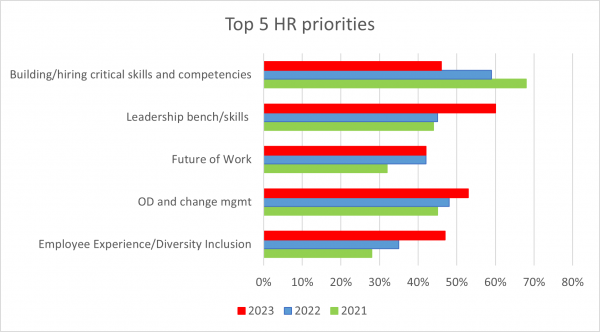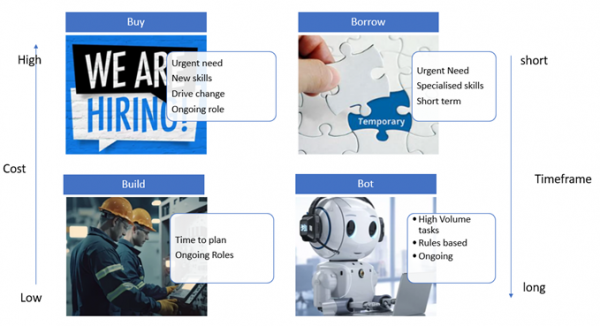People Capability - Five Key Questions
1. Skills Shortages - the Major People Challenge - How will that Evolve?
Globally the key staffing challenge facing most organisations is the skills shortage. The competition for talent is global. Manpower’s 2021 survey in 43 countries found that almost 70% of employers reported difficulty in finding skilled staff. The situation has not improved since.
Gartner Group survey HR priorities annually. Over the last three surveys most of the top priorities are skills related. The first three items in the chart all relate to acquiring skills. The last one is a proxy for initiatives to retain skilled staff.

COVID exacerbated the skills shortage by accelerating the use of technology and associated higher level skill requirements for the workforce.
Skill and ability is profoundly affected by education. Unfortunately, literacy rates are declining dangerously in New Zealand. The result is increasing competition between employers for staff at the upper end of the population skill and ability range.
Will impending recessionary times and the need to cut costs relieve the skills shortage?
In the short-term, significant job cuts from those organisations that are, or were, over staffed may dampen the labour market, to an extent.
Long term population demographics of aging populations and declining birth rates means proportionately fewer new entrants to the workforce. The skills shortage is likely to persist long term.
2. How do we Manage the Skills Crisis?
Four alternative strategies are advocated for skills acquisition - Buy, Build, Borrow or Bot (automate).

These neatly divide into short and long-term solutions. Buy and Borrow are short term, but potentially more costly strategies overall.
Building capability and automation are longer-term strategies that require up-front investment, but are more cost effective in the long run.
Every organisation will need a mix of these, depending on circumstances.
The Buy Strategy
Hire in the skills needed. Use this to fill a time-sensitive need that cannot be met internally. Use it when you want to bring in new perspectives and prompt change. Use for new initiatives – products and projects.
The downside is that it is costly in a competitive labour market and may drive up wages and salaries of other staff. Existing staff may be upset not to be offered the opportunity. One strategy for suitable roles is to look to the periphery of the traditional labour force and consider those typically excluded - older workers, women with young children, applicants with fewer qualifications.
The Borrow Strategy
Use freelancers, contractors and consultants, part-timers, on-call, or seasonal workers. This is very cost effective when specialised skills are needed for a period. Some of these workers can later be hired permanently.
The downside is less commitment and loyalty from ‘precarious’ staff and less familiarity with the organisation and its priorities.
The Build Strategy
Build staff capability for ongoing skill shortages. People are more engaged and loyal in organisations that give their staff opportunities to progress. This is more cost effective because salaries increase more slowly than market rates. For some roles people typically excluded from the workforce, those without qualifications and people with criminal records, can be a very cost-effective investment. Of course they must have the motivation and potential to learn.
The downside is that it takes time, planning and development resources. The risks are developing skills that are not utilised and losing trained staff to competitors.
The Bot Strategy (Automate)
This strategy is potentially highly cost effective. The choice of what to automate is critical. Focus should be on tasks that are high volume, repetitive and relatively simple; tasks that require pattern recognition of images and data rather than complex judgments; tasks that are rule-based so the steps can be defined.
The downside is that it requires an up-front investment in the technology, and the right task choices. There are many cases where technology has not delivered. Over-automated call centres fail because, although queries are high volume, they are also highly varied. Rules definitions cannot cover all cases.
3. So How Useful is AI?
In the technology field, AI - Machine Learning - is regarded as the latest, greatest initiative for almost everything, including people management activities.
AI is being extensively promoted for two areas of people and capability:
- Recruitment
- Skills management
Language is the currency of people and capability, and it is highly complex.
“We know from the science of linguistics and the philosophy of knowledge that [these programs] differ profoundly from how humans reason and use language. These differences place significant limitations on what these programs can do, encoding them with ineradicable defects.” Noam Chomsky ‘The False Promise of ChatGPT’ 8 March 2023 New York Times
AI in recruitment is used for scanning of resumés. Natural language programs match keywords in resumés to those deemed to be required or desirable for the position. Since there are multiple variations of language, terminology and syntax, it is not possible to cover them all.
Machines must be trained. Training data is information on successful candidates in historical non-digital selection processes. There are two more key problems:
First, to get sufficient training data, it likely comes from a different context.
Second, we know that manual selection processes are highly biased.
Machine learning inevitably perpetuates that bias.
An example is IT recruitment where AI has discriminated against females because most hires (historical training data) are male.
Add in the problems around the criteria for what is a successful hire. Ideally it would be successful job performance. However, research shows most performance ratings measure the relationship with the supervisor, not actual job performance.
Unsurprisingly, much of the promotion of Machine Learning is from technology vendors. The algorithms they use are not disclosed, so their effectiveness cannot be tested.
In the skills arena, AI is being promoted to help identify skills requirements by scraping vast quantities of data from multiple sources to identify themes. This may be helpful for very specialised areas but even then, the use of complex language is a problem.
A recent analysis for a client using our 360o feedback platform for leadership skills development found AI natural language programming methods were completely unable to pick out meaningful themes from the comments.
This is due to the huge variation in language used by the respondents in answer to the same two questions.
These issues have prompted increasing regulation in Europe and the US, restricting the use of AI Machine Learning in human resource decision-making activities.
4. What Then are the Best Approaches to Developing Capability?
The Gartner surveys on HR priorities identified the following issues which provide insight into perceived best practices:
- Need to understand what the skills gaps are
- Effectively integrate learning into day-to-day work
- Have learning resources for evolving skills needs
To solve these problems, organisations must have an accurate picture of what is involved in a job role or area of responsibility that is clearly aligned to the organisation’s priorities.
Very few organisations have this clarity. The result is that much of the resource allocated to training is not optimised, even wasted.
Despite this, 86% of New Zealand organisations surveyed by PWC on their strategy intentions for 2023 say they will be investing in upskilling their staff.
5. So what Information is Needed to make Upskilling Investments Work?
The first step is clearly defining job roles or responsibilities in terms of expected outcomes and continuously updating them as they evolve. This is an operational requirement, a fundamental leadership skill.
Competencies need to be defined. Knowledge and skill requirements are identified by working backwards from outcomes to the tasks or behaviours required to deliver those outcomes – then identifying the knowledge required and the observable skill steps involved.
Meta-competencies are very important for complex roles and neglected in many upskilling initiatives. They are essential for people to be more effective in developing new skills and to have the adaptability to apply their skills in new circumstances.
Meta-competencies are about self-awareness in terms of how we think, our motivations and feelings. Often taken as innate characteristics, research now shows they can be learnt.
Staff are more engaged and likely to stay when they can see potential career pathways within the organisation, the competency requirements for new roles and the resources to acquire those competencies.
For each piece of knowledge and skill there should be information on learning resources and how to access them. Ideally most resources are in the form of microlearning that can be used on-job, supported by on-job coaching - another key leadership skill requirement.
It is critical to distinguish between training and on-job competence. Training does not always translate to on-job competence.
Once skills and knowledge are defined, assessments identify competency levels and gaps.
This information is critical for staffing decisions, risk management, quality assurance and performance improvement as well as the engagement that comes from proactive staff career development.

